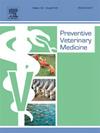The costs of the diagnosis and treatment of canine coccidioidomycosis in endemic regions, USA, 2022
IF 2.4
2区 农林科学
Q1 VETERINARY SCIENCES
引用次数: 0
Abstract
Coccidioidomycosis (“Valley fever”) is a fungal disease that causes a wide range of illness severity in animals and people. Here, we use U.S. Census data, surveys of pet ownership demographics, and results of a nation-wide dog serologic study to estimate the financial burden of the disease to dog owners. We estimate that the one-year cost of diagnosis and treatment for uncomplicated pulmonary coccidioidomycosis in dogs across 6 endemic southwestern U.S. states ranged from $60,117,875 to $74,858,713 before adjusting for inflation. The financial burden to dog owners for uncomplicated illness was 9–11 % of discretionary income during the first year of diagnosis and treatment. Adjusting for inflation from 2019 to 2022, the year of our coccidioidomycosis incidence data, the costs increase to $73,944,986 to $92,076,217 annually. In 2025 this increases further to $90,176,812 to $112,288,070. Though there is a lack of specific case numbers of disseminated or complicated coccidioidomycosis, the cost of care for dogs that require emergency care, advanced diagnostics, surgery, and second and third line drugs is higher, putting greater financial strain on dog owners.
美国流行地区犬球虫菌病的诊断和治疗费用,2022
球孢子菌病(“谷热”)是一种真菌疾病,可在动物和人类中引起各种严重疾病。在这里,我们使用美国人口普查数据、宠物主人人口统计调查和全国狗血清学研究的结果来估计疾病对狗主人的经济负担。我们估计,在通货膨胀调整之前,美国西南部6个州的犬类无并发症肺球虫菌病的一年诊断和治疗费用为60,117,875至74,858,713美元。在诊断和治疗的第一年,狗主人的经济负担为可自由支配收入的9 - 11% %。调整2019年至2022年的通货膨胀率,即我们的球虫菌病发病率数据的年份,成本每年增加到73,944,986美元至92,0076,217美元。到2025年,这一数字将进一步增至90,176,812美元至112,288,070美元。虽然传播性或复杂性球孢子菌病缺乏具体病例数,但需要紧急护理、先进诊断、手术和二线和三线药物的狗的护理费用较高,给狗主人带来了更大的经济压力。
本文章由计算机程序翻译,如有差异,请以英文原文为准。
求助全文
约1分钟内获得全文
求助全文
来源期刊

Preventive veterinary medicine
农林科学-兽医学
CiteScore
5.60
自引率
7.70%
发文量
184
审稿时长
3 months
期刊介绍:
Preventive Veterinary Medicine is one of the leading international resources for scientific reports on animal health programs and preventive veterinary medicine. The journal follows the guidelines for standardizing and strengthening the reporting of biomedical research which are available from the CONSORT, MOOSE, PRISMA, REFLECT, STARD, and STROBE statements. The journal focuses on:
Epidemiology of health events relevant to domestic and wild animals;
Economic impacts of epidemic and endemic animal and zoonotic diseases;
Latest methods and approaches in veterinary epidemiology;
Disease and infection control or eradication measures;
The "One Health" concept and the relationships between veterinary medicine, human health, animal-production systems, and the environment;
Development of new techniques in surveillance systems and diagnosis;
Evaluation and control of diseases in animal populations.
 求助内容:
求助内容: 应助结果提醒方式:
应助结果提醒方式:


